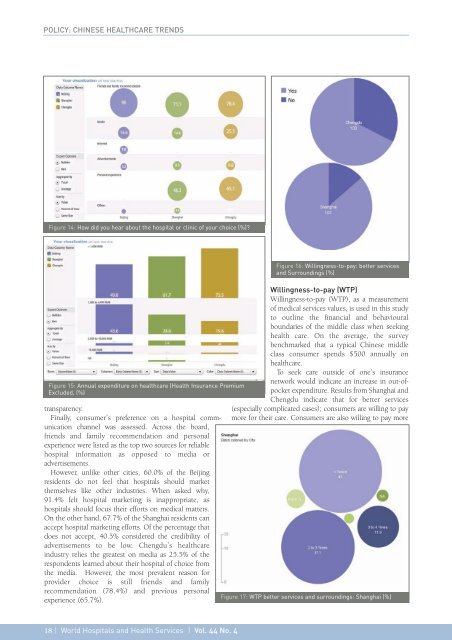World Hospitals and Health Services - International Hospital ...
World Hospitals and Health Services - International Hospital ...
World Hospitals and Health Services - International Hospital ...
You also want an ePaper? Increase the reach of your titles
YUMPU automatically turns print PDFs into web optimized ePapers that Google loves.
POLICY: CHINESE HEALTHCARE TRENDS<br />
Figure 14: How did you hear about the hospital or clinic of your choice (%)?<br />
Figure 15: Annual expenditure on healthcare (<strong>Health</strong> Insurance Premium<br />
Excluded, (%)<br />
transparency.<br />
Finally, consumer’s preference on a hospital communication<br />
channel was assessed. Across the board,<br />
friends <strong>and</strong> family recommendation <strong>and</strong> personal<br />
experience were listed as the top two sources for reliable<br />
hospital information as opposed to media or<br />
advertisements.<br />
However, unlike other cities, 60.0% of the Beijing<br />
residents do not feel that hospitals should market<br />
themselves like other industries. When asked why,<br />
91.4% felt hospital marketing is inappropriate, as<br />
hospitals should focus their efforts on medical matters.<br />
On the other h<strong>and</strong>, 67.7% of the Shanghai residents can<br />
accept hospital marketing efforts. Of the percentage that<br />
does not accept, 40.5% considered the credibility of<br />
advertisements to be low. Chengdu’s healthcare<br />
industry relies the greatest on media as 25.5% of the<br />
respondents learned about their hospital of choice from<br />
the media. However, the most prevalent reason for<br />
provider choice is still friends <strong>and</strong> family<br />
recommendation (78.4%) <strong>and</strong> previous personal<br />
experience (65.7%).<br />
Figure 16: Willingness-to-pay: better services<br />
<strong>and</strong> Surroundings (%)<br />
Willingness-to-pay (WTP)<br />
Willingness-to-pay (WTP), as a measurement<br />
of medical services values, is used in this study<br />
to outline the financial <strong>and</strong> behavioural<br />
boundaries of the middle class when seeking<br />
health care. On the average, the survey<br />
benchmarked that a typical Chinese middle<br />
class consumer spends $500 annually on<br />
healthcare.<br />
To seek care outside of one’s insurance<br />
network would indicate an increase in out-ofpocket<br />
expenditure. Results from Shanghai <strong>and</strong><br />
Chengdu indicate that for better services<br />
(especially complicated cases); consumers are willing to pay<br />
more for their care. Consumers are also willing to pay more<br />
Figure 17: WTP better services <strong>and</strong> surroundings: Shanghai (%)<br />
18 | <strong>World</strong> <strong><strong>Hospital</strong>s</strong> <strong>and</strong> <strong>Health</strong> <strong>Services</strong> | Vol. 44 No. 4
















